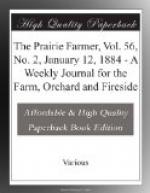“Perhaps these ideas might not be satisfactory to your people, and I have therefore set them forth somewhat at length in order that you may understand what I conceive should be the ruling principle of arrangement.”
I perceived that my visitor was somewhat disturbed and it was not till he had told me, in a kind of half apologetic way, that he did not know “but what I was pretty nigh right,” that he finally informed me that the square in question was already divided in the manner I described, by diagonal paths, and moreover that the paths were lined on each side by rows of well-grown trees.
I could not help inquiring what further laying out it required, and it then came out that there had been no thought of a re-arrangement of the component elements of the park in order to give it an expression of grace or beauty, but they had thought I might be able to make it attractive by the introduction of rustic arbors and gateways, or perhaps a fountain or “something of that sort to give it a stylish look.”
I gave him an advertising pamphlet containing designs and prices of garden ornaments, and told him they could select and order whatever they liked from the manufacturers,—but declined to give any advice which should connect my name with the work.
I have told this story as the readiest means of setting forth my ideas of the capabilities of such public areas, and also as an illustration of prevailing errors in regard to landscape gardening, which most people seem to think consists solely of extraneous, artificial decoration, by means of which any piece of ground can be made beautiful, however stiff and formal may be the arrangement of the trees, shrubbery, and lawns which give expression to its character as truly as the features of a human face.
Such squares as I have described are the most common and simple forms of public parks, and they might and should in all cases constitute not only a chief ornament of the town, but a most attractive place of resort for rest and refreshment. Nothing beyond the materials which nature furnishes is needed for the purpose, but it is essential that these should be gracefully dispersed, and that they should exhibit a luxuriant, healthy growth.
Above all we should avoid the introduction of artificial decorations which are intended to “look pretty.” If arbors or rests are needed, let them be placed at the points where they are obviously required, and be made of graceful patterns; but do not put elaborate structures of rustic work where no one will ever use them, and where in a few years they will be only dilapidated monuments of a futile effort at display.
The Village Improvement Societies which are everywhere springing up should devote their earliest efforts to the tasteful arrangement and care of these public ornamental areas, which should form the nucleus and pattern of the graceful expression which should pervade the streets.




